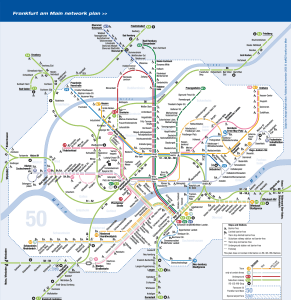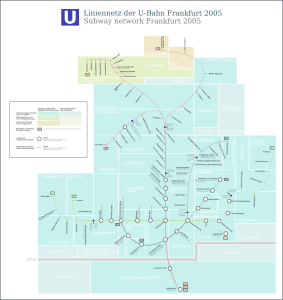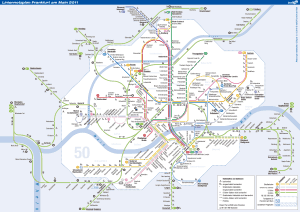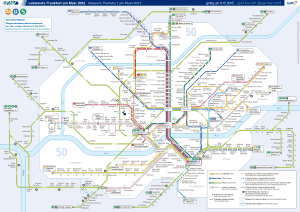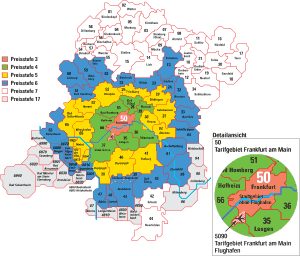Frankfurt subway, officially known as “Frankfurter U-Bahn”, is the underground transportation system that operates in the city of Frankfurt, Germany.
Inaugurated on 4 October 1968, The system has gone through several expansions, with the last one made in 2010.
At the moment, the metro has 9 lines that cover 86 stations, along 65 kilometres (about 40.39 miles). It is a vital network for the daily mobility of residents and tourists in the city..
Below we show you several Frankfurt subway maps. Click on the image to see it larger:
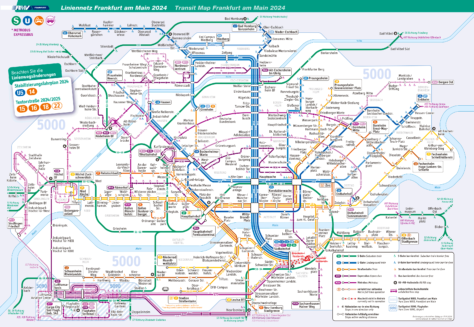
We have the previous map in PDF format.
And another version with more Frankfurt transport lines and the high-speed train:
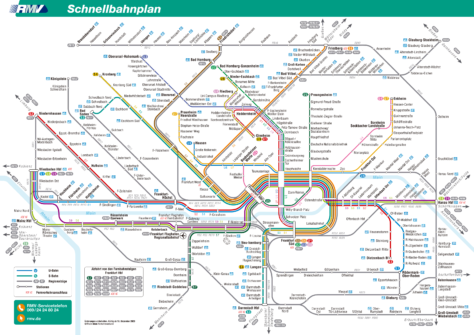
If you wish, have the same map in PDF format.
Official Web site
- For more information, visit the official site of the Frankfurt metro.
- Complete list of the tourist attractions in Frankfurt.
Metro timetable
The Frankfurt metro operates with the following schedules:
- Every day: of 4:00h until 1:00h.
Frankfurt subway fares
On the Frankfurt subway system, Rates are structured to suit different needs. In addition to single ticket options (Einzelfahrkarte) and day ticket (Tageskarte), there are other alternatives:
| Type of ticket | Precio (EUR) | Precio (USD) approximate* |
|---|---|---|
| Einzelfahrkarte (one-way ticket) | 3.40 € | ~3.70 $ |
| Tageskarte (daily ticket) | 8.10 € | ~8.80 $ |
| Wochenkarte (weekly ticket) | 31.55 € | ~34.20 $ |
| Monatskarte (monthly ticket) | 104.90 € | ~113.80 $ |
| Jahreskarte (annual ticket) | 1024.90 € | ~1111.30 $ |
*Use: Prices in dollars are approximated according to the current exchange rate and may vary.
These prices are for the Frankfurt area and may vary depending on the specific RMV zone.
Special Cards and Discounts:
- Frankfurt Card: This card offers unlimited travel on all RMV routes within the city, including the airport, during 1 o 2 days. Besides, provides discounts on admission to museums and other attractions such as the zoo and the Jardin de Palmas, and discounts on regular city tours and Rhine River cruises. The prices are 10.50 € for one day and 15.50 € for two days.
- Deutschland-Ticket: Allows unlimited travel throughout Germany on all means of local and regional public transport by 49 € per month.
- JobTicket: Offers reduced rates for companies that want to facilitate transportation for their employees, with various levels of service that adjust benefits and costs according to the needs of the company.
History of the subway

Frankfurt subway (U-Bahn) began operations in 1968, with the opening of its first line between Hauptwache y Nordweststadt. This work was developed in response to the growing need for more efficient public transportation to replace trams., they were overloaded.
Initial plans for the system date back to the 1990s. 1950, when various alternatives were discussed, including a full underground subway, a tram line with underground sections (Stadtbahn) and an elevated train. Finally, opted for a U-Bahn which would initially be a light rail system with underground sections in the center, with a view to becoming a full metro in the future.
Development began with the construction of line A in 1963. The first route, which was inaugurated in 1968, It comprised five underground stations in the city center and connected to the new underground terminal in Nordweststadt. During the years 70 y 80, the network experienced substantial growth with extensions to the northwest, the east and the south. In particular, the connection under the Main River to the district of Sachsenhausen was inaugurated in 1984, including the station Schweizer Platz.
XXI century
Network U-Bahn Frankfurt has grown to include nine lines, covering 86 stations and connecting various neighborhoods and suburbs. Careful planning allowed the incorporation of underground sections in the center and at-grade or elevated sections in the suburbs, giving the system a unique combination of metro and light rail features.
The system is currently managed by the company Verkehrsgesellschaft Frankfurt (VGF) under the framework of the association Rhein-Main-Verkehrsverbund (RMV). In the last decade, The network has been modernized and already transports more than 130 million passengers annually.
The last station opened in the Frankfurt underground is the station Gateway Gardens, which is part of line S9 of the S-Bahn Rhein-Main. This station was inaugurated on 14 December 2019 and it is very important because it gives access to the Frankfurt airport, making life easier for travelers and airport workers..
History of the Frankfurt subway map
In the early stages, The design of the Frankfurt subway map were simple diagrams showing the few operational lines. One of the first designers to shape the graphic structure of the map was Otl Aicher, a renowned German designer known for his work on iconography for the Munich Olympic Games in 1972. His minimalist approach pioneered the clear representation of routes.
Over time, as new lines and stations were added, The map design was updated to include more information, ensuring clear and easy guidance for passengers. Designers like Hartmut Esslinger contributed in more recent years to maintaining the modern and understandable aesthetic of the map, which today shows a network of routes interconnected with other modalities of public transport, including trams and regional trains.
The Frankfurt metro map has also been influenced by intermodality with the S-Bahn (suburban train) and the extensive urban bus network. The different lines are coded by color and number to facilitate navigation for residents and visitors, integrating the network in a logical way for everyone.
Additional data
The Frankfurt Metro connects passengers to some of the city's most prominent points of interest:
- Römerberg (Season Dom/Römer): The heart of the old town, with historic buildings and the iconic Römer, town hall headquarters.
- Museum of Modern Art (Season Dom/Römer): A major museum housing a notable collection of contemporary art.
- Main Tower (Season Willy-Brandt-Platz): This skyscraper offers stunning panoramic views of Frankfurt and its surroundings.
- Museo Städel (Season Schweizer Platz): An art gallery exhibiting collections from the Middle Ages to contemporary times.
- Botanical Garden Palmengarten (Season Bockenheimer Warte): A vast park that displays a great diversity of flora.
Old Frankfurt subway maps
At a historical level, We are posting old maps related to the subway in this section. At the moment they are of the year 2014 and previous years:
The previous map in PDF format: traffiQ_Liniennetzplan_2011.
The same previous map, but in PDF format: MAPA-oficial-traffiQ_Liniennetzplan_2013.
